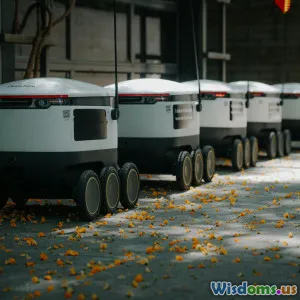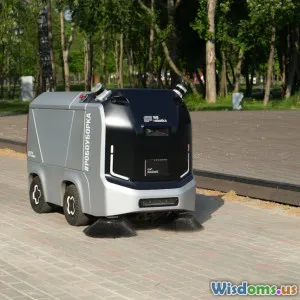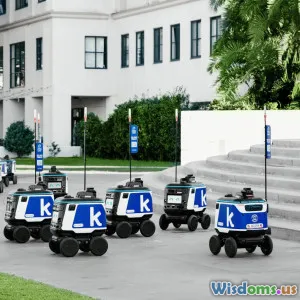
Top 10 Sci Fi Gadgets Now Becoming Reality in 21st Century
9 min read Explore the top 10 sci-fi gadgets becoming reality today & see how future tech is shaping our world. (0 Reviews)
Top 10 Sci-Fi Gadgets Now Becoming Reality in 21st Century
Science fiction has long served as a beacon of future possibilities, pushing the boundaries of imagination about what technology might achieve. Today, many gadgets once relegated to the realms of fantasy are rapidly becoming real inventions that are reshaping our daily lives, industries, and even human potential. This article uncovers the top 10 science fiction gadgets from classic and modern sci-fi lore that have transitioned into the tangible, innovative technologies of the 21st century.
1. Holographic Displays
The Sci-Fi Promise
From Star Wars’ iconic Princess Leia projection to Iron Man’s interactive 3D interfaces, holograms offer immersive, spatial visualizations that transcend screens.
Today’s Reality
Companies like Looking Glass Factory have developed holographic displays that can project 3D images visible to the naked eye. Real-time interactive holograms are emerging in sectors like medical imaging, where surgeons can visualize anatomy in 3D before operations. Microsoft’s HoloLens also blends holography and augmented reality to overlay digital content in real spaces.
According to a 2023 report by MarketsandMarkets, the holographic display market is expected to grow from $4.5 billion in 2021 to $12.3 billion by 2026, underpinning expanding commercial adoption.
2. Voice-Activated AI Assistants
The Sci-Fi Promise
Devices like Star Trek’s computer showcased intuitive, conversational AI always ready to assist.
Today’s Reality
Amazon Alexa, Google Assistant, and Apple’s Siri have entered millions of homes worldwide, interpreting natural language and managing countless tasks, from controlling smart homes to integrating with cars. Advances in natural language processing (NLP) have dramatically enhanced these assistants’ responsiveness and contextual understanding.
NPR reports that 50% of US households own a smart speaker, signaling deep penetration.
3. Neural Interfaces and Brain-Computer Interaction
The Sci-Fi Promise
Neural implants in The Matrix or Ghost in the Shell offered direct mind-machine communication.
Today’s Reality
Neuralink, spearheaded by Elon Musk, is developing implantable brain-computer interfaces (BCI) to allow direct communication between the human brain and computers. Recent experiments show primates controlling computers with thought. Such tech promises breakthroughs in paralysis treatment and cognitive enhancement.
According to a 2022 Nature Biomedical Engineering review, neural interfaces are becoming increasingly viable and could transform medicine and human-computer interaction.
4. Autonomous Vehicles
The Sci-Fi Promise
Flying cars and self-driving vehicles are staples of futuristic cities, like in Blade Runner.
Today’s Reality
Tesla, Waymo, and other industry leaders have advanced self-driving cars that can navigate roads with minimal human input. Autonomous delivery drones and trucks are in pilot stages. The ethical, regulatory, and technological hurdles remain, but features like Tesla's Full Self-Driving (FSD) system show concrete progress.
The IIHS notes that semi-autonomous systems have already begun lowering accident rates by reducing driver error.
5. Wearable Health Monitors
The Sci-Fi Promise
In Star Trek, tricorders could instantly scan and diagnose health conditions.
Today’s Reality
Apple Watch, Fitbit, and other wearables continuously collect vital health data including heart rate, oxygen levels, and ECGs, alerting users and physicians to abnormalities. Advanced biosensors and AI-driven analytics provide predictive health insights.
The global wearable medical device market is projected to reach $27.8 billion by 2026, reflecting consumer and medical adoption.
6. Personal Flying Devices
The Sci-Fi Promise
Jetpacks and personal hovercraft feature in dozens of sci-fi films, symbolizing ultimate personal transport freedom.
Today’s Reality
Companies like Jetpack Aviation and Gravity Industries have produced working jetpack prototypes. While commercial use is limited by fuel technology and safety, test flights demonstrate human-controlled personal flight is feasible now.
Urban Air Mobility projects envision flying taxis becoming common in the near future, ushering in a new transport era.
7. Universal Translators
The Sci-Fi Promise
Devices like the Babel fish in The Hitchhiker’s Guide to the Galaxy promised instant translation of any language.
Today’s Reality
Apps like Google Translate and real-time translation earbuds (e.g., WT2 Plus) offer near-instant translation across dozens of languages with high accuracy. AI-driven language models verify nuances, accents, and context far better than previous tools.
This technology helps break language barriers globally, improving communication in diplomacy, travel, and business.
8. Advanced Robotics
The Sci-Fi Promise
Robots from I, Robot and Ex Machina were envisioned as autonomous workmates and companions capable of complex tasks and emotions.
Today’s Reality
Boston Dynamics’ robots like Atlas and Spot precisely navigate challenging terrain with impressive agility. AI-enabled robots perform surgery, warehouse automation, and customer service roles, showing increased autonomy and learning abilities.
Sophia by Hanson Robotics exemplifies humanoid robotics pushing social and emotional AI frontiers.
9. Smart Contact Lenses
The Sci-Fi Promise
Tech embedded in eyewear was omnipresent in Minority Report and Black Mirror, presenting data overlays without bulky hardware.
Today’s Reality
Companies including Mojo Vision are developing smart contact lenses featuring micro-displays that provide heads-up display (HUD) capabilities directly on the eye. Potential applications include navigation, health monitoring, and AR without external devices.
Challenges include miniaturization, safety, and power supply, but recent prototypes closely resemble the sci-fi vision.
10. Molecular 3D Printing
The Sci-Fi Promise
Replicators in Star Trek could create any object or food on demand at the molecular level.
Today’s Reality
3D printing leaps from plastic prototypes to bioprinting organs, food, and complex molecular structures. Companies like Organovo print human tissues for medical research. Innovators are exploring atomic-scale 3D printing to assemble matter precisely, potentially revolutionizing manufacturing and healthcare.
According to SmarTech Analysis (2023), the 3D bioprinting market could surpass $2.5 billion by 2028.
Conclusion
The 21st century is witnessing a remarkable convergence of science fiction concepts and real-world breakthroughs. The once-imaginary gadgets from futuristic tales are morphing into transformative technologies impacting health, transport, communication, and human interaction. These innovations not only amplify human capabilities but also pose profound societal and ethical questions. As we continue to innovate, the boundary between fiction and reality grows ever thinner — inspiring us to dream boldly and engineer wisely, propelling humanity into a future once only envisioned under the glow of sci-fi imagination.
Embracing these technologies requires public awareness, robust policies, and ongoing research to harness benefits while mitigating challenges. The gadgets that once belonged solely to the realm of storybooks are proving that the future arrives faster than we think, heralding an exciting new era for humanity.
Rate the Post
User Reviews
Popular Posts




















